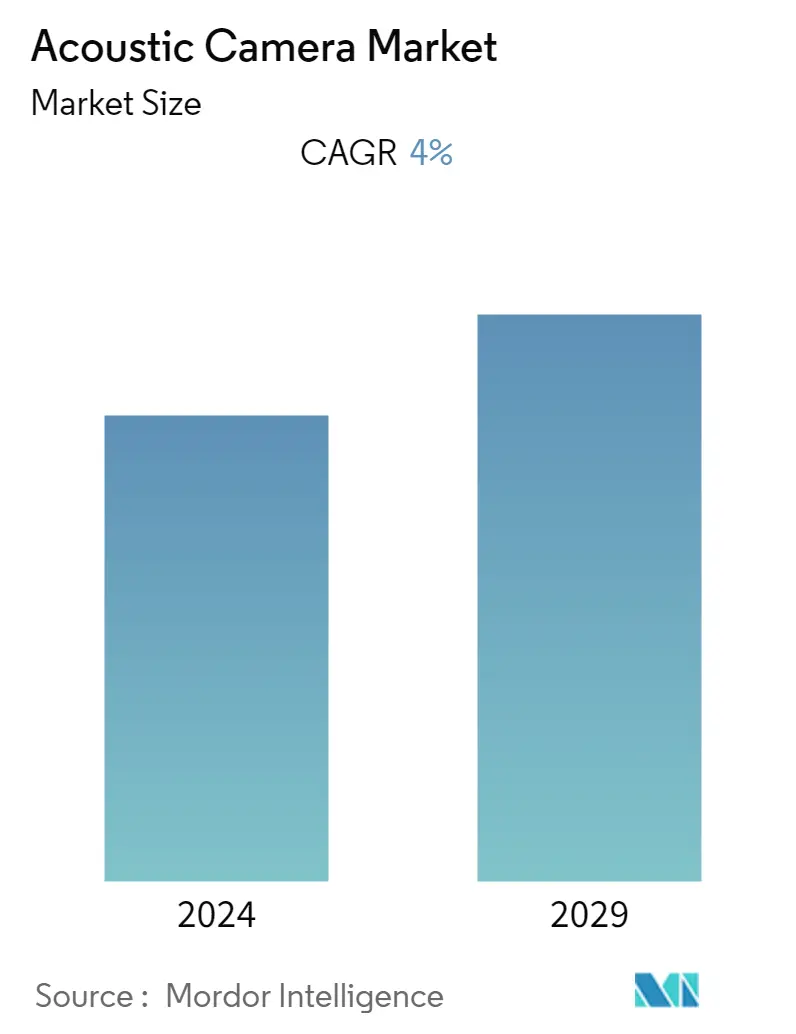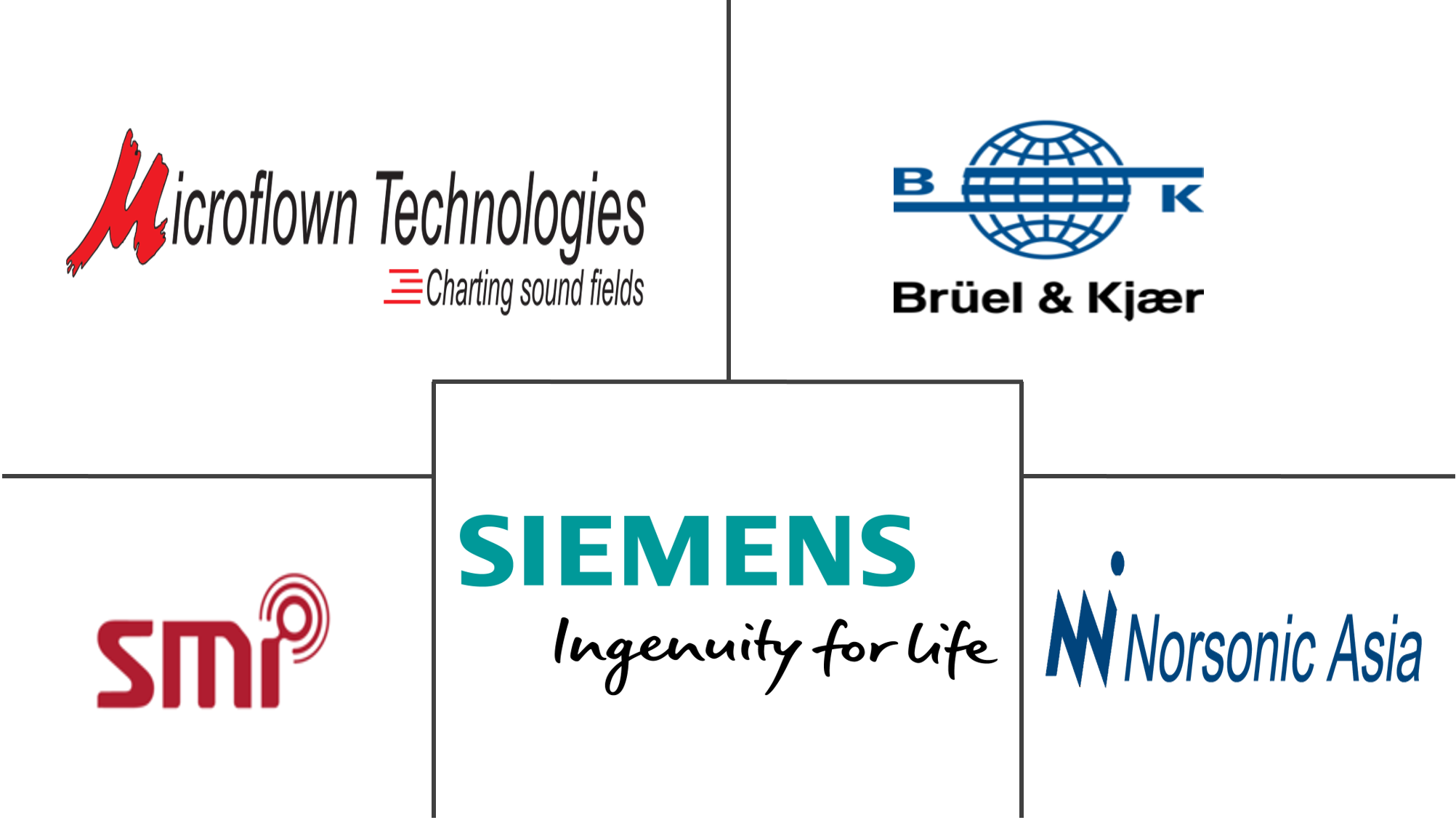Market Size of Acoustic Camera Industry

| Study Period | 2019 - 2029 |
| Base Year For Estimation | 2023 |
| CAGR | 4.00 % |
| Fastest Growing Market | Asia Pacific |
| Largest Market | North America |
| Market Concentration | Low |
Major Players
*Disclaimer: Major Players sorted in no particular order |
Acoustic Camera Market Analysis
The Acoustic Camera Market is expected to register a CAGR of 4% over the forecast period (2022 - 2027). Some key drivers responsible for the market's growth include the growing adoption of room and building acoustics and emerging audio and video combined microphone and camera array technology.
- An acoustic camera is an innovative way of locating, visualizing, quantizing, and identifying sound sources. It uses the capabilities of a microphone array with a camera to "paint" a picture of the sound and the various sound intensities. The rise in demand for process automation, adoption of artificial intelligence and machine learning, and stringent regulation against noise pollution are primarily responsible for the growth of the acoustic camera market.
- There are many applications of the acoustic camera, with most focusing on noise reduction. The camera is frequently applied to improve the noise emission of vehicles like cars, airplanes, trains, and other structures like wind turbines. In the industrial sector, compressed air leaks, vacuum system leaks, and electrical partial discharge are all expensive system issues that consume power, causing companies to deal with unforeseen costs and potential production/uptime issues. Ultrasound imaging with an acoustic camera effectively detects these equipment issues as part of a complete asset management plan. This easy-to-use technology typically allows professionals to complete their inspections faster than traditional methods.
- The current trend moves toward adopting computing power and analytics provided by the acoustic imaging camera and any companion software by significant players. For instance, a camera, such as the FLIR Si124, offers on-camera analytics, easy-to-understand reporting, and predictive analysis using an AI/web tool. An inspector can classify leak severity, perform leak cost analysis, and do partial discharge pattern analysis in rreal timeduring a survey. Once the survey is complete, the inspector must automatically connect to their Wi-Fi network to upload images to the acoustic camera viewer.
- Recently, acoustic analysis attracted more attention and is being applied in many fields, such as speech recognition. However, due to background noise, condition-monitoring methods based on acoustic analysis are still tricky in an industrial environment. For many years, diagnostics in the industry were performed "by ear," with subsequent assessment of the emitted sound. Still, the influence of background noise can strongly affect the quality of such a judgment.
- To meet the various demands of the customer, the acoustics camera firms are expanding their product portfolio by introducing new products. For instance, in December 2021, The new acoustic camera SONASCREEN was added to the product line of SONOTEC, the Halle, Germany-based ultrasonic experts. The camera uses audible and ultrasonic frequency ranges to produce acoustic images. The tool makes it simple for maintenance crews to find leaks in compressed air and vacuum systems. By introducing the new industrial imager, SONOTEC offers an additional tool for energy auditing and predictive maintenance, ensuring operational dependability and efficiency. It is provided at a competitive price to make the SONASCREEN accessible to many clients and their applications.
- In acoustic cameras, many microphones are included to enhance the detection range and the number of data signals required for processing. This significantly increases the requirement for processing power, increasing the cost of the final product. Furthermore, the gap between the acoustic image pixel rises with an increase in distance. The availability of limited pixels availability is limited, which often makes it difficult to determine the exact location of the sound source.
- The COVID-19 pandemic affected the operations of microphone market players and the businesses of companies related to microphones, including acoustic cameras. However, the healthcare sector gained the market's growth. For instance, during the pandemic, a cough-detection camera contributed to the prevention and early detection of epidemics in public places.
Acoustic Camera Industry Segmentation
An acoustic camera is an imaging device that is used to locate sound sources and characterize these sound sources. The acoustic camera consists of a group of microphones, also called a microphone array, that is simultaneously acquired to represent the sound sources' location.
The scope of the study focuses on a global market analysis of acoustics camera products. Market sizing encompasses the revenue generated through acoustics camera products across the globe sold by various market players. The study also tracks the key market parameters, underlying growth influencers, and major vendors operating in the industry, which supports the market estimations and growth rates over the forecast period. The study further analyzes the overall impact of Covid-19 on the ecosystem. The report's scope encompasses market sizing and forecast for segmentation by array type, end-user industry, and geography.
| By Array Type | |
| 2D | |
| 3D |
| By End-user Industry | |
| Automotive | |
| Aerospace | |
| Electronics | |
| Energy & Power | |
| Other End-user Industries |
| By Geography | ||||||
| ||||||
| ||||||
| ||||||
|
Acoustic Camera Market Size Summary
The Acoustic Camera Market is poised for growth, driven by the increasing adoption of room and building acoustics, as well as advancements in audio and video combined microphone and camera array technology. Acoustic cameras, which utilize microphone arrays and cameras to visualize sound sources and intensities, are gaining traction due to the rising demand for process automation and the integration of artificial intelligence and machine learning. The market is also bolstered by stringent regulations against noise pollution. These cameras find extensive applications in noise reduction across various sectors, including automotive, aerospace, and industrial manufacturing, where they help identify and mitigate noise emissions from vehicles, wind turbines, and industrial equipment. The technology's ability to enhance inspection efficiency and reduce unforeseen costs associated with equipment failures further propels its adoption.
The market landscape is characterized by a fragmented competitive environment, with key players like Microflown Technologies, SM Instruments Inc., and Siemens Product Lifecycle Management Software Inc. actively engaging in product launches and strategic mergers and acquisitions. The Asia Pacific region is expected to witness significant growth, driven by the booming automotive and manufacturing industries, alongside rising disposable incomes. The aerospace sector's expansion in the region also contributes to the demand for acoustic cameras. Recent developments, such as the introduction of new acoustic camera models with enhanced detection capabilities, underscore the industry's focus on innovation and meeting diverse customer needs. As the market continues to evolve, the integration of advanced analytics and predictive maintenance features is anticipated to offer lucrative opportunities for growth.
Acoustic Camera Market Size - Table of Contents
-
1. MARKET INSIGHTS
-
1.1 Market Overview
-
1.2 Industry Value Chain Analysis
-
1.3 Industry Attractiveness - Porter's Five Forces Analysis
-
1.3.1 Threat of New Entrants
-
1.3.2 Bargaining Power of Buyers
-
1.3.3 Bargaining Power of Suppliers
-
1.3.4 Threat of Substitute Products
-
1.3.5 Intensity of Competitive Rivalry
-
-
1.4 Assessment of the Impact of COVID-19 on the Market
-
-
2. MARKET SEGMENTATION
-
2.1 By Array Type
-
2.1.1 2D
-
2.1.2 3D
-
-
2.2 By End-user Industry
-
2.2.1 Automotive
-
2.2.2 Aerospace
-
2.2.3 Electronics
-
2.2.4 Energy & Power
-
2.2.5 Other End-user Industries
-
-
2.3 By Geography
-
2.3.1 North America
-
2.3.1.1 United States
-
2.3.1.2 Canada
-
-
2.3.2 Europe
-
2.3.2.1 Germany
-
2.3.2.2 United Kingdom
-
2.3.2.3 France
-
2.3.2.4 Rest of Europe
-
-
2.3.3 Asia Pacific
-
2.3.3.1 China
-
2.3.3.2 Japan
-
2.3.3.3 India
-
2.3.3.4 Rest of Asia Pacific
-
-
2.3.4 Rest of the World
-
2.3.4.1 Latin America
-
2.3.4.2 Middle East and Africa
-
-
-
Acoustic Camera Market Size FAQs
What is the current Acoustic Camera Market size?
The Acoustic Camera Market is projected to register a CAGR of 4% during the forecast period (2024-2029)
Who are the key players in Acoustic Camera Market?
Microflown Technologies, Norsonic AS, SM Instruments Inc., Bruel & Kjær Sound & Vibration Measurement A/S and Siemens Product Lifecycle Management Software Inc. are the major companies operating in the Acoustic Camera Market.

